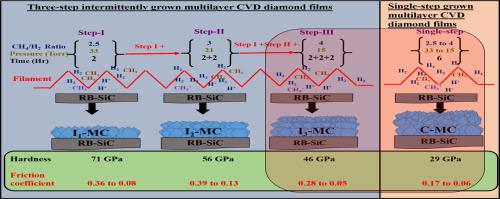当前位置:
X-MOL 学术
›
Diam. Relat. Mater.
›
论文详情
Our official English website, www.x-mol.net, welcomes your
feedback! (Note: you will need to create a separate account there.)
A comparative study of the mechanical and tribological properties of intermittently and continuously grown multilayer diamond films on RB-SiC
Diamond and Related Materials ( IF 4.3 ) Pub Date : 2020-12-01 , DOI: 10.1016/j.diamond.2020.108140 G. Selva Prabhakaran , Subramshu S. Bhattacharya , M.S. Ramachandra Rao
Diamond and Related Materials ( IF 4.3 ) Pub Date : 2020-12-01 , DOI: 10.1016/j.diamond.2020.108140 G. Selva Prabhakaran , Subramshu S. Bhattacharya , M.S. Ramachandra Rao

|
Abstract Multilayer diamond films were deposited on a reaction bonded silicon carbide (RB-SiC) substrate by a single-step continuous process as well as a three-step intermittent process in a hot filament chemical vapour deposition (HF-CVD) equipment. The recipes of HF-CVD during the single-step multilayer film (C-MC) were selected by varying the CH4/H2 concentration and chamber pressure such that the initially deposited diamond grains were microcrystalline, which became progressively finer with further deposition. In the case of the intermittently grown films (Ix-MC), a one, two and three-layered structure, each layer having a gradual decrease in grain size was deposited with the same recipes as that of the C-MC. All the films were characterised using SEM, AFM and Raman spectroscopy. Fine grains in the range of 0.2–0.7 μm were identified in the C-MC and sharply faceted diamond crystallites having sizes between 0.5- 2 μm were seen in the intermittently deposited coatings. The hardness values were 71 GPa, 56 GPa and 46 GPa for the intermittent coatings. In contrast, a lower hardness of 29 GPa was obtained in C-MC. The friction coefficients of all the diamond films were measured up to 106 sliding cycles (530 m) using a ball-on-disc universal tribometer. In the initial stages of sliding, the continuously grown C-MC exhibited a friction coefficient ~0.17, while the intermittently coated three-layered film (I3-MC) showed a friction coefficient of 0.28. However, beyond 40,000 sliding cycles, the friction coefficient of I3-MC showed a value of ~0.05, which was slightly lower than C-MC (~0.06).
中文翻译:

RB-SiC 上间歇和连续生长的多层金刚石薄膜的力学和摩擦学性能比较研究
摘要 在热丝化学气相沉积(HF-CVD)设备中,通过单步连续工艺和三步间歇工艺在反应键合碳化硅(RB-SiC)衬底上沉积多层金刚石薄膜。通过改变 CH4/H2 浓度和腔室压力来选择单步多层膜 (C-MC) 中 HF-CVD 的配方,使得最初沉积的金刚石晶粒为微晶,随着进一步沉积,其逐渐变得更细。在间歇生长的薄膜 (Ix-MC) 的情况下,一层、两层和三层结构,每层具有逐渐减小的晶粒尺寸,使用与 C-MC 相同的配方沉积。所有薄膜均使用 SEM、AFM 和拉曼光谱进行表征。0.2-0 范围内的细晶粒。在 C-MC 中鉴定出 7 μm,并且在间歇沉积的涂层中可以看到尺寸在 0.5-2 μm 之间的锐利刻面金刚石微晶。间歇涂层的硬度值为71 GPa、56 GPa和46 GPa。相比之下,在 C-MC 中获得了 29 GPa 的较低硬度。所有金刚石薄膜的摩擦系数都使用球盘式通用摩擦计测量了 106 次滑动循环 (530 m)。在滑动的初始阶段,连续生长的 C-MC 的摩擦系数约为 0.17,而间歇涂覆的三层膜 (I3-MC) 的摩擦系数为 0.28。然而,超过 40,000 次滑动循环后,I3-MC 的摩擦系数为~0.05,略低于 C-MC(~0.06)。在间歇沉积的涂层中可以看到 5-2 μm。间歇涂层的硬度值为71 GPa、56 GPa和46 GPa。相比之下,在 C-MC 中获得了 29 GPa 的较低硬度。所有金刚石薄膜的摩擦系数都使用球盘式通用摩擦计测量了 106 次滑动循环 (530 m)。在滑动的初始阶段,连续生长的 C-MC 的摩擦系数约为 0.17,而间歇涂覆的三层膜 (I3-MC) 的摩擦系数为 0.28。然而,超过 40,000 次滑动循环后,I3-MC 的摩擦系数为~0.05,略低于 C-MC(~0.06)。在间歇沉积的涂层中可以看到 5-2 μm。间歇涂层的硬度值为71 GPa、56 GPa和46 GPa。相比之下,在 C-MC 中获得了 29 GPa 的较低硬度。所有金刚石薄膜的摩擦系数都使用球盘式通用摩擦计测量了 106 次滑动循环 (530 m)。在滑动的初始阶段,连续生长的 C-MC 的摩擦系数约为 0.17,而间歇涂覆的三层膜 (I3-MC) 的摩擦系数为 0.28。然而,超过 40,000 次滑动循环后,I3-MC 的摩擦系数为~0.05,略低于 C-MC(~0.06)。在 C-MC 中获得了 29 GPa 的较低硬度。所有金刚石薄膜的摩擦系数都使用球盘式通用摩擦计测量了 106 次滑动循环 (530 m)。在滑动的初始阶段,连续生长的 C-MC 的摩擦系数约为 0.17,而间歇涂覆的三层膜 (I3-MC) 的摩擦系数为 0.28。然而,超过 40,000 次滑动循环后,I3-MC 的摩擦系数为~0.05,略低于 C-MC(~0.06)。在 C-MC 中获得了 29 GPa 的较低硬度。所有金刚石薄膜的摩擦系数都使用球盘式通用摩擦计测量了 106 次滑动循环 (530 m)。在滑动的初始阶段,连续生长的 C-MC 的摩擦系数约为 0.17,而间歇涂覆的三层膜 (I3-MC) 的摩擦系数为 0.28。然而,超过 40,000 次滑动循环后,I3-MC 的摩擦系数为~0.05,略低于 C-MC(~0.06)。而间歇涂覆的三层膜(I3-MC)的摩擦系数为0.28。然而,超过 40,000 次滑动循环后,I3-MC 的摩擦系数为~0.05,略低于 C-MC(~0.06)。而间歇涂覆的三层膜(I3-MC)的摩擦系数为0.28。然而,超过 40,000 次滑动循环后,I3-MC 的摩擦系数为~0.05,略低于 C-MC(~0.06)。
更新日期:2020-12-01
中文翻译:

RB-SiC 上间歇和连续生长的多层金刚石薄膜的力学和摩擦学性能比较研究
摘要 在热丝化学气相沉积(HF-CVD)设备中,通过单步连续工艺和三步间歇工艺在反应键合碳化硅(RB-SiC)衬底上沉积多层金刚石薄膜。通过改变 CH4/H2 浓度和腔室压力来选择单步多层膜 (C-MC) 中 HF-CVD 的配方,使得最初沉积的金刚石晶粒为微晶,随着进一步沉积,其逐渐变得更细。在间歇生长的薄膜 (Ix-MC) 的情况下,一层、两层和三层结构,每层具有逐渐减小的晶粒尺寸,使用与 C-MC 相同的配方沉积。所有薄膜均使用 SEM、AFM 和拉曼光谱进行表征。0.2-0 范围内的细晶粒。在 C-MC 中鉴定出 7 μm,并且在间歇沉积的涂层中可以看到尺寸在 0.5-2 μm 之间的锐利刻面金刚石微晶。间歇涂层的硬度值为71 GPa、56 GPa和46 GPa。相比之下,在 C-MC 中获得了 29 GPa 的较低硬度。所有金刚石薄膜的摩擦系数都使用球盘式通用摩擦计测量了 106 次滑动循环 (530 m)。在滑动的初始阶段,连续生长的 C-MC 的摩擦系数约为 0.17,而间歇涂覆的三层膜 (I3-MC) 的摩擦系数为 0.28。然而,超过 40,000 次滑动循环后,I3-MC 的摩擦系数为~0.05,略低于 C-MC(~0.06)。在间歇沉积的涂层中可以看到 5-2 μm。间歇涂层的硬度值为71 GPa、56 GPa和46 GPa。相比之下,在 C-MC 中获得了 29 GPa 的较低硬度。所有金刚石薄膜的摩擦系数都使用球盘式通用摩擦计测量了 106 次滑动循环 (530 m)。在滑动的初始阶段,连续生长的 C-MC 的摩擦系数约为 0.17,而间歇涂覆的三层膜 (I3-MC) 的摩擦系数为 0.28。然而,超过 40,000 次滑动循环后,I3-MC 的摩擦系数为~0.05,略低于 C-MC(~0.06)。在间歇沉积的涂层中可以看到 5-2 μm。间歇涂层的硬度值为71 GPa、56 GPa和46 GPa。相比之下,在 C-MC 中获得了 29 GPa 的较低硬度。所有金刚石薄膜的摩擦系数都使用球盘式通用摩擦计测量了 106 次滑动循环 (530 m)。在滑动的初始阶段,连续生长的 C-MC 的摩擦系数约为 0.17,而间歇涂覆的三层膜 (I3-MC) 的摩擦系数为 0.28。然而,超过 40,000 次滑动循环后,I3-MC 的摩擦系数为~0.05,略低于 C-MC(~0.06)。在 C-MC 中获得了 29 GPa 的较低硬度。所有金刚石薄膜的摩擦系数都使用球盘式通用摩擦计测量了 106 次滑动循环 (530 m)。在滑动的初始阶段,连续生长的 C-MC 的摩擦系数约为 0.17,而间歇涂覆的三层膜 (I3-MC) 的摩擦系数为 0.28。然而,超过 40,000 次滑动循环后,I3-MC 的摩擦系数为~0.05,略低于 C-MC(~0.06)。在 C-MC 中获得了 29 GPa 的较低硬度。所有金刚石薄膜的摩擦系数都使用球盘式通用摩擦计测量了 106 次滑动循环 (530 m)。在滑动的初始阶段,连续生长的 C-MC 的摩擦系数约为 0.17,而间歇涂覆的三层膜 (I3-MC) 的摩擦系数为 0.28。然而,超过 40,000 次滑动循环后,I3-MC 的摩擦系数为~0.05,略低于 C-MC(~0.06)。而间歇涂覆的三层膜(I3-MC)的摩擦系数为0.28。然而,超过 40,000 次滑动循环后,I3-MC 的摩擦系数为~0.05,略低于 C-MC(~0.06)。而间歇涂覆的三层膜(I3-MC)的摩擦系数为0.28。然而,超过 40,000 次滑动循环后,I3-MC 的摩擦系数为~0.05,略低于 C-MC(~0.06)。











































 京公网安备 11010802027423号
京公网安备 11010802027423号